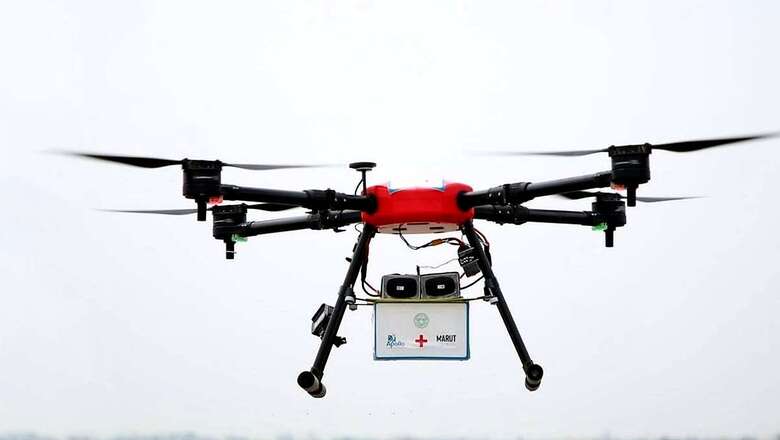
views
As India opens its arms to embrace a liberalized drone ecosystem with the Draft Drone Rules 2021 (currently open for public consultation), the drone industry is eyeing a boundless sky for the drones to take off. However, there is a long way to go for India to develop its own indigenous drone industry.
India is currently home to over 100 drone manufacturing companies that largely import the drone components and assemble the complete drone locally. The nation is yet to witness the production of a drone that is fully designed and manufactured in India.
The reason can mainly be attributed to our country predominantly being focused on services and not manufacturing. For the few industries like electronics or automotive where India is focused on manufacturing, the design, technology, manufacturing expertise, and subsequent machine tools come through a technology transfer approach. This does not upskill our talent pool and neither does it help evolve our manufacturing and development infrastructure.
Further, our component manufacturing ecosystem remains underdeveloped to support the development of indigenous prototypes largely because they are not able to manufacture components at costs similar to their foreign counterparts. In such a scenario, even the largest drone manufacturers in the country are forced to import crucial components for drones, depriving India of a chance to go truly atmanirbhar with a fully indigenously developed drone.
On the contrary, China’s focus to design and build products for the entire world coupled with their conducive manufacturing ecosystem has given a boost to the production scale of both cheaper and sophisticated product range, catering to diverse segments right from agricultural spraying to photography to surveying and inspections.
Their secret sauce? A strong ecosystem consisting of networked suppliers, component manufacturers, and drone companies which are backed by policies that promote manufacturing and financial incentives along with a deep focus on research, development and testing and IP (intellectual property) creation.
If India has to take a lead in the emerging sector of drones, the following steps are a must:
1. Focus on IP Creation Mindset, Incentivize the Same
Intellectual Property (IP) is a trivial deciding factor when we take the revenue and costs of any product in some measure to consider the feasibility of its manufacturing. An average iPhone, for instance, designed in the US is sold for $1499 and costs about $490 to manufacture in China. The revenue beyond the cost of manufacturing, which is a monumental two-thirds in this case, gets retained with the original label holding the IP rights over the product. That’s the leverage a high-value IP provides over a quantitative manufacturing ecosystem. As a nation aiming to become the manufacturing hub for a newly developing technology, it is important that we motivate the citizens to create our own IPs competing with global technology and incentivize the same to boost revenue generation for our country.
2. Create R&D and Innovation-focused Ecosystem
India has long been a country of bright technical minds that often turn to the western world for research infrastructure and high-paying technology jobs. India needs to retain its best minds by creating a robust R&D-oriented ecosystem with special enabling policies and infrastructure, particularly in the case of emerging technologies. Innovation-focused public private partnership programmes coupled with product management approaches like iDEX by the Ministry of Defence can play a major role here.
3. Adopt Global Standards and Robust Certification Mechanism
The transition from being an importer to a global exporter that the world looks up to will demand that we comply with the global standards and maintain a world-class quality that can be seen as trustworthy in the long run. Robust certification programmes for drones under collaboration of organisations like Quality Council of India, Directorate General of Aeronautical Quality Assurance (DGAQA) and Centre for Military Airworthiness and Certification (CEMILAC) can help in realizing this faster and distinguish India as a leading hub for manufacturing-related solutions.
4. Need Trade Promotion & Business Opportunities
Drones provide a significant advantage in increasing efficiency, saving cost and reducing the risk of operations in numerous sectors, right from crop health monitoring in agriculture, asset inspections, construction progress monitoring, mining surveys and land record mapping. There needs to be ample awareness about the benefits of drones. Large initiatives involving drones as the primary technology, much like SVAMITVA Project by the Ministry of Panchayati Raj, need to be conceptualized that can create large-scale demand for drones in India.
5. Preference for Indigenous Products for Procurement
To encourage the Make in India initiative for the drone industry, it is important to ensure profitable procurements in a timely manner. Preference to locally manufactured products during the large industry and defence procurements will further encourage the indigenous manufacturers, reinforcing their zeal in making India the drone hub we have always aspired to be.
The author serves as the Director of the Drone Federation of India and plays a prominent role in drone policy advocacy by interacting with civil and defence government agencies as well as public and private sector enterprises for creating opportunities and building a robust drone ecosystem in India. The views expressed in this article are those of the author and do not represent the stand of this publication.
Read all the Latest News, Breaking News and Coronavirus News here.



















Comments
0 comment